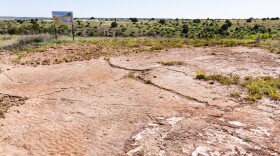New research has found flash flooding events are likely to become more severe in the future if carbon dioxide emissions continue at their current rate.
Using climate simulations and modeling that examined the years 2070-2100, the research team from the University of Oklahoma, the National Oceanic and Atmospheric Administration and the National Center for Atmospheric Research predicts flash flooding could happen more rapidly and that the events would produce higher flood peaks — a concept the team terms “flashiness.” If emissions remain at the same level, the central U.S. will emerge as a flash flood hotspot with an 8.5% increase in flashiness.
Other areas may see even more impact — the Southwest U.S. is expected to experience a 10% increase in flashiness. Overall, the projections demonstrated flash flooding is gradually moving toward the north.
The study was led by Yang Hong, a professor of hydrology and remote sensing at the University of Oklahoma. Hong said in a press release that compounding the issue is also how often these floods would happen — 20-year return floods will more likely occur every two to five years. To prepare for these events, he said community education should be a priority.
“For example, every Saturday in Norman, we can hear the tornado warning siren. But we don’t have the flash flood drills, because they’re too different,” Hong said in an interview with StateImpact. “When a tornado happens, you’re trying to find the cover, shelter. But when flash flooding happens, you want to go to higher ground, you don’t want to find a cover or [go] underground. We don’t have that kind of training yet. I think it’s something we need to address in the future.”
Outside of heat, flash flooding is the leading cause of weather-related deaths in the country, and over half of flood-related drownings involve vehicles.
JJ Gourley, a research hydrometeorologist with the NOAA National Severe Storms Laboratory, also worked on the study. He said education is a major component to surviving these severe weather events, and sometimes the solutions are simple: just stay home.
“It’s pretty rare for a flood to come find you in your home,” Gourley said. “We find that less than 10% of fatalities from flash flooding occur that way. … If there’s a flooded roadway in front of you, don’t drive through it. Go back and find a different way to get to that destination.”
He said while the best solution would be to reduce emissions, there are also steps to take in the meantime. Bolstering flooding infrastructure, he said, should be prioritized, and measures should be taken to protect vulnerable residents.
“There is a lot of low-income housing in areas that are prone to flooding, around rivers that are prone to flooding, in low-lying areas,” Gourley said. “So there could be some ways to provide incentives to move people out of those regions and prepare for this.”
The team said the next step in the research is to explore other regions outside of the continental U.S. and to look at different emissions scenarios. Hong said he hopes the study will shine a spotlight on the severity of flash flooding.
“The public tend to overlook the seriousness of the flash floods,” Hong said. “Because we hear about hurricanes, we hear about tornados. And the flash flooding is more [analogous] to the tornadoes because it’s fast, it’s hard to predict, it’s hard to respond. We’d like [if] the media could probably pay more attention to flash floods — not just the hurricanes and the tornadoes.”
StateImpact Oklahoma is a partnership of Oklahoma’s public radio stations which relies on contributions from readers and listeners to fulfill its mission of public service to Oklahoma and beyond. Donate online.









